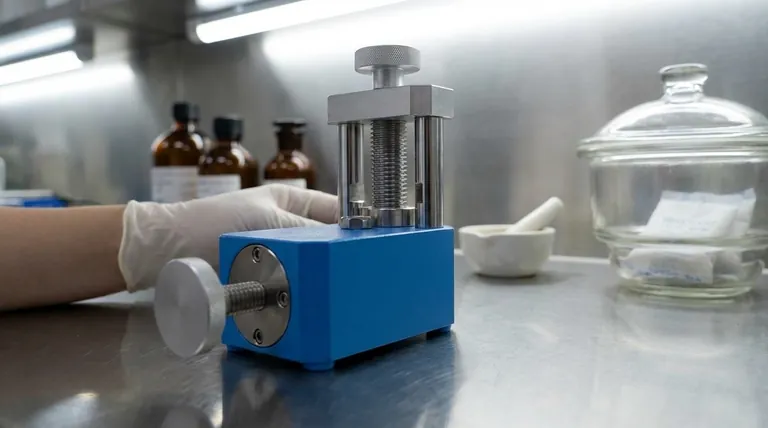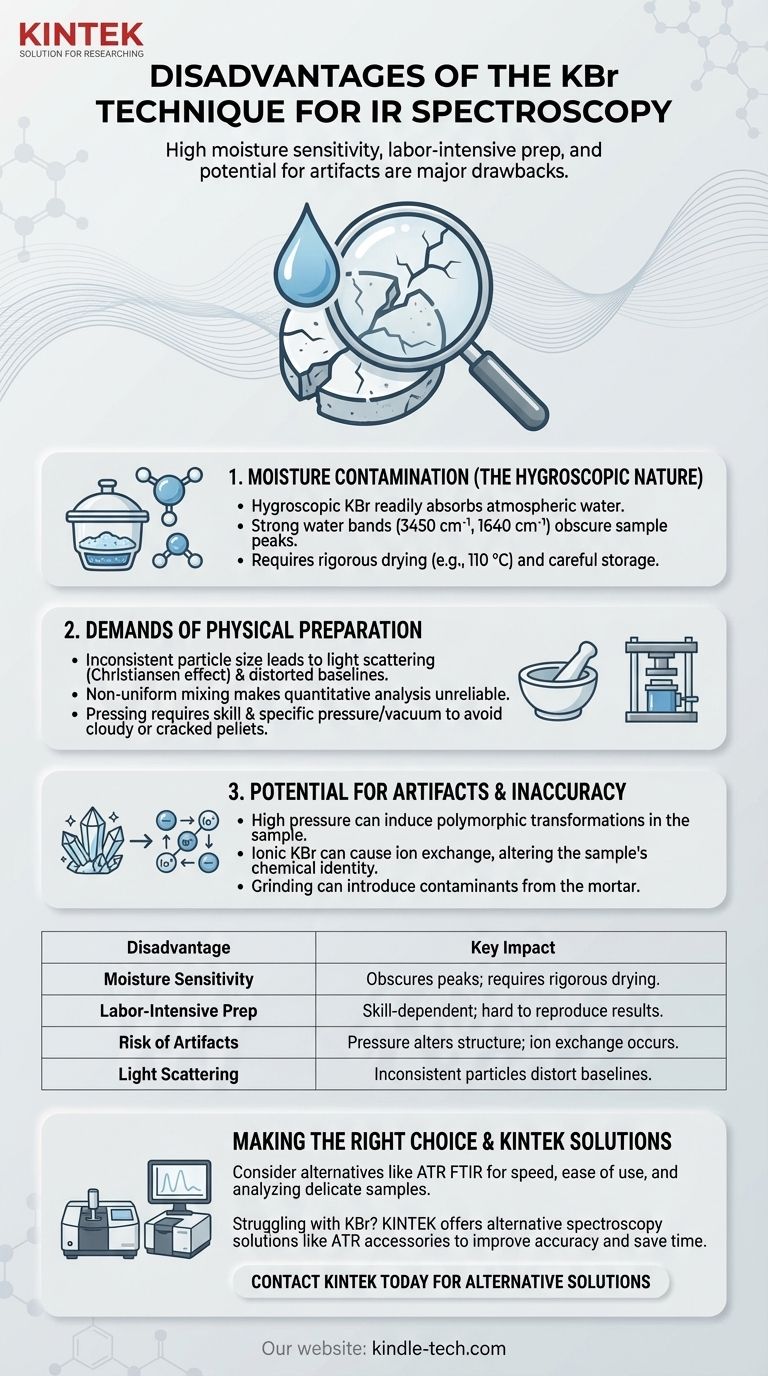The primary disadvantages of the KBr technique for infrared (IR) spectroscopy are its high sensitivity to moisture, its labor-intensive and technique-sensitive sample preparation process, and its potential to introduce spectral artifacts or even alter the sample itself. While capable of producing high-quality spectra, the method is riddled with potential sources of error that demand significant care and expertise to overcome.
The core challenge of the KBr pellet method isn't just the work involved; it's the numerous sources of potential error—from atmospheric moisture to physical inconsistencies in the pellet—that can compromise the accuracy and reproducibility of your spectral data.

The Inherent Problem: Moisture Contamination
The most persistent issue with using potassium bromide (KBr) is its interaction with water. This single characteristic is responsible for the most common failures and spectral inaccuracies.
KBr's Hygroscopic Nature
Potassium bromide is highly hygroscopic, meaning it readily absorbs moisture directly from the atmosphere. Even brief exposure to ambient air is enough for the KBr powder to become contaminated with water.
The Impact on Your Spectrum
This absorbed water is not a passive contaminant. It produces very strong and broad absorption bands in the IR spectrum, primarily in the 3450 cm⁻¹ region (O-H stretching) and around 1640 cm⁻¹ (H-O-H bending). These large, intrusive peaks can easily overlap with and obscure important peaks from your actual sample, such as N-H or O-H stretches, making interpretation difficult or impossible.
The Need for Rigorous Drying
To combat this, KBr must be thoroughly dried in an oven (e.g., 110 °C for several hours) and stored in a desiccator. This adds a time-consuming but non-negotiable step to the workflow and requires constant vigilance to prevent re-exposure to moist air during sample preparation.
The Demands of Physical Preparation
Beyond the chemical challenge of moisture, the physical process of creating the pellet is a significant source of disadvantage, requiring both specialized equipment and skill.
Inconsistent Particle Size
For a transparent pellet, the sample and KBr must be ground into an extremely fine powder. If particles are too large, they will scatter the infrared light rather than transmit it. This scattering effect (known as the Christiansen effect) results in a distorted, sloping baseline and can reduce the accuracy of peak intensities.
Non-Uniform Mixing
Achieving a homogenous mixture of the sample and KBr is critical. If the sample is not distributed evenly throughout the pellet, the resulting peak intensities will not be representative of the bulk material, making quantitative analysis unreliable.
The Art of Pressing
Creating the pellet requires a hydraulic press to apply several tons of pressure and a vacuum die to remove trapped air. Insufficient vacuum leads to cloudy, brittle pellets that scatter light. Incorrect pressure can cause the pellet to crack or be opaque. This step is as much an art as it is a science, making it difficult to achieve consistent results, especially for inexperienced users.
Understanding the Trade-offs: Potential for Artifacts and Inaccuracy
The preparation process doesn't just risk poor quality; it can actively change your results in ways that are difficult to predict.
Physical and Chemical Interactions
The high pressure used to form the pellet can induce polymorphic transformations in crystalline samples, changing their crystal structure and thus their IR spectrum. Furthermore, the ionic nature of KBr can lead to ion exchange with certain samples, particularly halide salts (e.g., amine hydrochlorides), creating a new compound within the pellet and producing a spectrum that does not represent the original material.
The Challenge of Reproducibility
Due to the many variables—moisture content, particle size, mixing uniformity, grinding time, and pressing pressure—reproducibility is a major disadvantage. Achieving identical spectra from the same sample prepared on different days or by different operators is exceptionally difficult.
Contamination from Grinding
The act of grinding the sample and KBr, typically with a mortar and pestle, can itself introduce contaminants. This can abrade material from the mortar surface, adding unwanted impurities to the pellet.
Making the Right Choice for Your Goal
The KBr technique is a classic method, but its disadvantages mean it is not always the best tool for the job. Modern alternatives often provide more reliable data with far less effort.
- If your primary focus is speed, ease of use, or routine screening: Use Attenuated Total Reflectance (ATR) FTIR. It requires virtually no sample preparation and eliminates all the issues associated with KBr.
- If your primary focus is reliable quantitative analysis: The KBr method can work, but it requires extremely rigorous and consistent procedures. ATR or solution-based transmission methods are often more reproducible.
- If your primary focus is analyzing a delicate, pressure-sensitive, or salt-based sample: Avoid the KBr pellet method. The high pressure can alter the sample, and ion exchange can corrupt your data. Consider ATR or a diffuse reflectance technique instead.
Ultimately, understanding the inherent disadvantages of the KBr pellet method empowers you to choose the right analytical technique for your specific objective.
Summary Table:
| Disadvantage | Key Impact |
|---|---|
| Moisture Sensitivity | Obscures sample peaks with water bands; requires rigorous drying. |
| Labor-Intensive Prep | Demands skill for grinding, mixing, and pressing; hard to reproduce. |
| Risk of Artifacts | High pressure can alter crystal structure or cause ion exchange. |
| Light Scattering | Inconsistent particle size leads to distorted baselines. |
Struggling with inconsistent IR results from KBr pellets? KINTEK specializes in laboratory equipment and consumables for spectroscopy. Our experts can help you select the right alternative technique, like ATR accessories, to save time and improve accuracy. Contact our team today to optimize your lab's workflow!
Visual Guide

Related Products
- kbr pellet press 2t
- Laboratory Hydraulic Press Split Electric Lab Pellet Press
- Automatic Laboratory Hydraulic Pellet Press Machine for Lab Use
- Laboratory Hydraulic Pellet Press for XRF KBR FTIR Lab Applications
- Automatic Laboratory Hydraulic Press for XRF & KBR Pellet Press
People Also Ask
- How do you prepare a KBr pellet for IR spectroscopy? Master the Key Steps for a Clear Spectrum
- How do you prepare samples for infrared spectroscopy? Master Solid, Liquid & Gas Techniques
- Why KBr is used for IR spectroscopy? The Ideal Medium for Solid Sample Analysis
- What are the safety precautions for KBr? Achieve Flawless FTIR Pellet Preparation and Data Accuracy
- How much sample is needed for IR? Optimize Your Analysis with Minimal Material



















